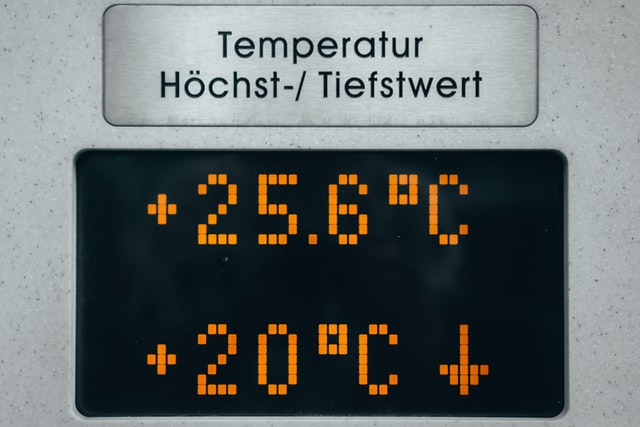Temperature plays an important role in affecting human health. There are not many research studies available in this aspect; still the evidence available is enough to show that temperature affects the human health negatively.
- Both higher and lower temperatures can decrease the performance and hinder the learning activity.
- For regions with temperate or cold climates, temperature between 220C and 240 C is suitable for cognitive development and better work performance.
- Lower temperatures may increase the risk of virus viability, cardiovascular and respiratory diseases; whereas the higher temperature can be responsible for dry eyes and respiratory symptoms (Wolkoff et al., 2021).
- Temperature also affects the mortality rate, according to records of the Federal Bureau for Statistics of Germany; the mortality rate was lowest during the summer and was highest during the winter between the years 1946-1995 (Lerchl, 1998).
- Temperature also significantly contributes to the stress levels both physical and mental, since the stress put on the humans by high air temperatures is higher (Hondula et al., 2015).
Another study conducted in Australia showed that the extreme heat events have led to at least 5332 fatalities between the years 1844 to 2010 (Coates et al., 2014). Extreme heat events can be deadly to human health causing cardiovascular, respiratory and dermatological disorders as well as heat strokes and induced by body’s inability to control its internal temperature with reference to the surrounding external temperatures. During heat strokes, the body temperature increases rapidly causing the sweating mechanism to fail and hence the body does not cool down as required. This is one of the most serious heat-related illnesses that can cause death or permanent disability if the treatment is not provided on time.
The populations that are most prone to heat strokes are small children, the elderly, and people suffering from chronic diseases, the low-income population, and outdoor workers.
Dehydration and heat stroke induced dehydration can lead to hyponatremia which is sever loss of sodium salts from the body. The country-level mortality data of the U.S between 1968 to 2002 have shown that temperature more than 900 F and less than 400 F is statistically related to an increase in annual mortality rate. The data indicate that the annual mortality rate increases by 0.1% if the everyday temperature is above 900 F. Although cold-related mortality is not higher than heat-related mortality but temperatures below 400 F are also associated with significant mortality. This temperature-related mortality varies with different age groups, where the old groups are at higher risk (Deschenes, 2014). Other than physical health problems, temperature affects mental health too.
- Higher temperature increases the risk of mental illness, suicides, and poor mental health.
- The cold temperature decreases the negative effect on mental health whereas, the hot temperatures increase them (Mullins and White, 2019). Temperature affects human health in the form of eye strain, fatigue, and discomfort too (Xiong et al., 2015).
High-temperature increase mortality risk on the current and next day of the heat events, showing an immediate heat effect on mortality (Kouis et al., 2019). When the temperature in the airways decreases, it gives rise to a vulnerable condition in which the concentration of oxygen increases and temperature decreases. The low temperatures increase the dissolution of oxygen in plasma and blood oxidation favors the seasonality of infections that affects the respiratory system (camuffo, 2021).
It is evident that both low and high temperature has a remarkable effect on human health and is associated with triggers for various existing diseases.
References
- Camuffo, D. (2021). A relationship between temperature, oxygen dissolved in blood and viral infections. Annals of Geophysics, 64(1), PA109-PA109.
- Coates, L., Haynes, K., O’brien, J., McAneney, J., & De Oliveira, F. D. (2014). Exploring 167 years of vulnerability: An examination of extreme heat events in Australia 1844–2010. Environmental Science & Policy, 42, 33-44.
- Deschenes, O. (2014). Temperature, human health, and adaptation: A review of the empirical literature. Energy Economics, 46, 606-619.
- Hondula, D. M., Balling, R. C., Vanos, J. K., & Georgescu, M. (2015). Rising temperatures, human health, and the role of adaptation. Current Climate Change Reports, 1(3), 144-154.
- Kouis, P., Kakkoura, M., Ziogas, K., Paschalidou, A. Κ., & Papatheodorou, S. I. (2019). The effect of ambient air temperature on cardiovascular and respiratory mortality in Thessaloniki, Greece. Science of the Total Environment, 647, 1351-1358.
- Lerchl, A. (1998). Changes in the seasonality of mortality in Germany from 1946 to 1995: the role of temperature. International journal of biometeorology, 42(2), 84-88.
- Mullins, J. T., & White, C. (2019). Temperature and mental health: Evidence from the spectrum of mental health outcomes. Journal of health economics, 68, 102240.
- Wolkoff, P., Azuma, K., & Carrer, P. (2021). Health, work performance, and risk of infection in office-like environments: The role of indoor temperature, air humidity, and ventilation. International Journal of Hygiene and Environmental Health, 233, 113709.
- Xiong, J., Lian, Z., Zhou, X., You, J., & Lin, Y. (2015). Effects of temperature steps on human health and thermal comfort. Building and Environment, 94, 144-154.
- Zhang, Y., Fan, X., Zhang, X., Ma, P., Wang, S., & Zheng, C. (2019). Moderately cold temperature associates with high cardiovascular disease mortality in China. Air Quality, Atmosphere & Health, 12(10), 1225-1235.
- https://www.cdc.gov/climateandhealth/pubs/extreme-heat-final_508.pdf Accessed on 12-03-2022
